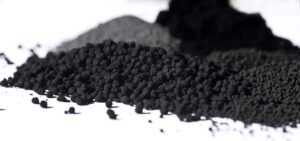
Sustainable Batteries: Greener Carbons for Enhanced Performance

Elektrodenstapel für die Zellfertigung
K. Selsam / Fraunhofer ISC
Lithium-ion batteries require in addition to lithium metal a number of sophisticated functional materials for their performance. Some of them sound rather unspectacular: conductive additives. In fact, conductive additives like carbon black or carbon nanotubes are a decisive component for the performance and environmental benignity of lithium-ion batteries. The recently launched collaborative project HiQ-CARB aims to provide new carbons with a superior performance and a low carbon footprint for future green batteries in Europe. HiQ-CARB is receiving EU funding from EIT RawMaterials to scale up and validate this important battery material.
Meanwhile it’s well known: Li-ion batteries are a key technology for trendsetting European industries such as electric vehicles, portable electronic devices or a wide range of other applications where renewable energy is stored and supplied. Large sectors of European industry, including the European automotive industry, are increasingly dependent on imported lithium-ion cells. The European Green Deal and various supporting actions aim to exploit the employment, growth and investment potential of batteries. A competitive manufacturing value chain in Europe is to be created – last but not least to foster green battery technologies with improved environmental performance.
What about carbon in lithium-ion batteries?

Orion Engineered Carbons GmbH
Carbon plays a critical role in improving the electronic conductivity of battery cathodes and thus is essential to achieve fast charging and discharging rates. In the growing battery market, the raw materials account for the biggest part of the costs in the production. “In order to sustainably supply the growing European battery industry with high-quality conductive additives, low carbon footprint and resource-efficient carbon materials have to be created, validated and economically produced in a sufficient volume in Europe” explains project coordinator Dr. Andreas Bittner from Fraunhofer Institute for Silicate Research ISC. That’s what HiQ-CARB wants to achieve.
Smart combination, processing and learning
The project team of HiQ-CARB relies on very profiled companies as ARKEMA or ORION for the production of advanced additives and Customcells for the battery cell production. On the other side well-known R&D partners like Fraunhofer Institute for Silicate Research ISC, Aalto University and the University of Bordeaux are involved for the scientific part of evaluation and testing of the new material combinations itselves and the battery cells made from them.
The HiQ-CARB approach for advanced carbon additives is the combination of thin carbon nanotubes and Acetylene black beads thus receiving high conductivity and low CO2 emissions during fabrication. In combination, they form an ideally conducting network within the battery electrode. The project aims to build up production of these specialty materials on a ton-scale and megaton-scale as well as an efficient processing for the cathode fabrication on a pilot scale. The test specifications and routines for qualification and quality assurance have to be developed and established to provide effective quality management during production.
In addition, the HiQ-CARB team will provide knowledge and learning modules supporting the education of future experts on the lithium battery value chain and participation opportunities for industry and research according to the EIT RawMaterials‘ education recommendations.
How carbons go greener
Carbon black is usually produced with high amounts of energy and process materials. HiQ-CARB will substitute standard conductive carbon black by new and much greener high-quality acetylene black. This contributes greatly to improved environmental performance, e. g. the reduction of the CO₂ footprint of material production. In addition, the already commercialized standard carbon nanotubes will be replaced with much thinner carbon nanotubes. This leads to less amounts of carbon materials for the same or even better battery performance and leads to an improved resource efficiency. In addition, this is the only nanotube material worldwide produced from a renewable bioethanol feedstock. Furthermore, a life cycle analysis will be carried out during the project to assess the sustainability of the production process.
Visit our Website: https://www.isc.fraunhofer.de/de/presse-und-medien/presseinformationen/HiQ-CARB-…
Project information on the EIT RawMaterials website
https://eitrawmaterials.eu/project/hiq-carb
HiQ-CARB. High-Quality Conductive Additives for Rechargeable Batteries
Duration 2021-01-01 – 2024-09-30
Partners
Fraunhofer-Gesellschaft zur Förderung der angewandten Forschung e.V. / Fraunhofer Institute for Silicate Research ISC, Germany (project coordinator)
Aalto University, Finland
Arkema France, France
Custom Cells Itzehoe GmbH, Germany
Orion Engineered Carbons GmbH, Germany
Université de Bordeaux, France
Wissenschaftliche Ansprechpartner:
Dr. Andreas Bittner | andreas.bittner@isc.fraunhofer.de | Fraunhofer-Institut für Silicatforschung ISC, Würzburg l www.isc.fraunhofer.de









![[Figure 1] Schematic of next-generation CNT-PANI composite fiber supercapacitor and comparison graph with recent results](https://www.innovations-report.com/wp-content/uploads/2025/05/KIST_leads_next-generation_energy_storage_technolo_1746783279-e1746784635527-362x245.jpg)


